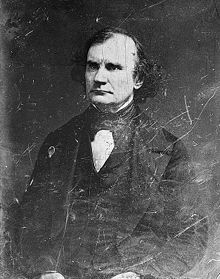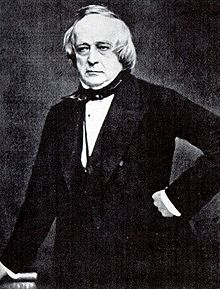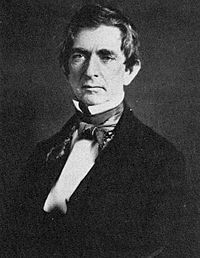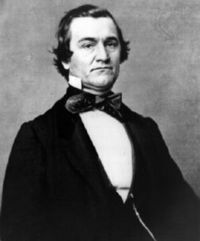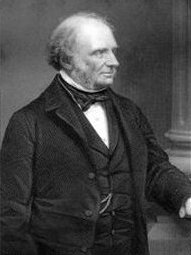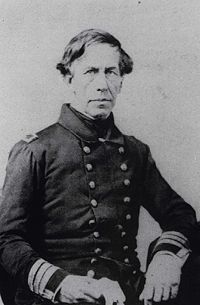Trent Affair
The Trent Affair, also known as the Mason and Slidell Affair, was an international diplomatic incident that occurred during the American Civil War. On November 8, 1861, the USS San Jacinto, commanded by Captain Charles Wilkes, intercepted the British mail packet HMS Trent and removed two Confederate diplomats, James Mason and John Slidell. The envoys were bound for Great Britain and France in order to press the Confederacy’s case for diplomatic recognition by Europe.
The initial reaction in the United States was enthusiastically in support of the capture, but many American leaders had doubts as to the wisdom and the legality of the act. In the Confederate States, the hope was that the incident would lead to a permanent rupture in Union-British relations, diplomatic recognition, and Southern independence. In Great Britain, the public expressed outrage to this apparent insult to their national honor, and the British government demanded an apology and the release of the prisoners while it took steps to strengthen its military forces in Canada and in the Atlantic Ocean.
After several weeks of tension, during which the United States and the United Kingdom came dangerously close to war, the issue was resolved when the Lincoln administration released the envoys and disavowed Captain Wilkes’ actions. No formal apology was issued. Mason and Slidell resumed their voyage to England, but failed in their goal of achieving diplomatic recognition. The Union had successfully navigated its way through its most crucial diplomatic challenge of the war.
General background
The Confederacy, and its president Jefferson Davis, believed from the beginning that European dependence on cotton for its textile industry would lead to diplomatic recognition and intervention, in the form of mediation.
The Union‚Äôs main focus in foreign affairs was just the opposite‚ÄĒto prevent any British recognition of the South that might encourage France and other nations to follow suit. There had been continuous improvement in Anglo-American relations throughout the 1850s. The issues of the "Oregon territory, British involvement in Texas, and the Canadian border dispute" had all been resolved. Secretary of State William H. Seward, the primary architect of American foreign policy during the war, intended to maintain the policy principles that had served the country well since the American Revolution‚ÄĒnonintervention by the United States in the affairs of other countries and resistance to foreign intervention in the affairs of the United States and other countries in the Western hemisphere.[1]
At the beginning of the Civil War, the United States minister to Great Britain was Charles Francis Adams. Appointed in early March 1862, Adams delayed his departure to England to attend the wedding of his son and did not arrive until May 13. An important part of his mission was to make clear to the British that the war was strictly an internal insurrection, affording the Confederacy no rights under international law. Any movement by Britain towards officially recognizing the Confederacy would be considered an unfriendly act towards the United States.
The issue of diplomatic recognition
The Trent affair did not erupt as a major crisis until late November and December of 1861. The first link in the chain of events was forged in February 1861, when the Confederacy created a three person European delegation consisting of William Lowndes Yancey, Pierre Rost, and Ambrose Dudley Mann. Their instructions from Confederate Secretary of State Robert Toombs were to explain to these governments the nature and purposes of the southern cause, to open diplomatic relations, and to ‚Äúnegotiate treaties of friendship, commerce, and navigation.‚ÄĚ Toomb‚Äôs instructions included a long legal argument on states‚Äô rights and the right of secession. By relying on the two-pronged attack of cotton and legality, many important issues were absent from the instructions, including the blockade of Southern ports, privateering, trade with the North, and slavery.[2]
The pursuit and capture
The intended departure of the diplomats was no secret and the Union government received daily intelligence on their movements. By October 1, Slidell and Mason were in Charleston. Their original plan was to attempt to run the blockade in the CSS Nashville, a fast steamer, but the main channel into Charleston was guarded by five Union ships and the Nashville’s draft was too deep for any side channels. A night escape was considered, but tides and strong night winds prevented this. An overland route through Mexico and departure from Matamoros was also considered, but the delay of several months was unacceptable.[3]
The steamer Gordon was used as an alternative. It had a shallow enough draught to use the back channels and was capable of speeds exceeding twelve knots, more than enough to elude Union pursuit. Renamed the Theodora, the ship left Charleston on October 12. On the 14th, they arrived at Nassau but had missed connections with the British steamer going to St. Thomas, the main point of departure for British ships from the Caribbean to Great Britain.[4] They moved on towards Cuba and arrived in Cardenas on October 16. They learned that the next British mail packet would leave Havana on November 7, for St. Thomas.[5]
On the Union side, the USS ''San Jacinto, commanded by Captain Charles Wilkes, arrived in St. Thomas on October 13. Wilkes’ orders were to join a U.S. Naval force preparing for an assault of Port Royal, South Carolina. He learned that Mason and Slidell were scheduled to leave Havana on November 7, in the RMS Trent. He realized that the ship would need to use the narrow Bahama Channel. Wilkes discussed legal options with his second in command, Lt. D. M. Fairfax, before making plans to intercept and also reviewed law books on the subject. He decided that Mason and Slidell would qualify as contraband, subject to seizure by a United States ship.[6]
The Trent left as scheduled with Mason, Slidell, their secretaries, and Slidell’s wife and children aboard. Around noon on the 8th, the San Jacinto spotted the Trent, and two shots were fired across her bow. Captain Moir of the Trent ignored the first shot but stopped after the second one. Two cutters from the San Jacinto had been prepared for boarding, but Fairfax first went over to the Trent in a third cutter. Wilkes had given Fairfax the following written instructions:
On boarding her you will demand the papers of the steamer, her clearance from Havana, with the list of passengers and crew.
Should Mr. Mason, Mr. Slidell, Mr. Eustice, and Mr. McFarland be on board, make them prisoners and send them on board this ship and take possession of her [the Trent] as a prize. … They must be brought on board.
All trunks, cases, packages and bags belonging to them you will take possession of and send on board this ship; any dispatches found on the persons of the prisoners, or in possession of those on board the steamer, will be taken possession of, examined, and retained if necessary.
Fairfax boarded alone and was escorted to Captain Moir. Captain Moir refused Fairfax’s request for a passenger list, but Slidell and Mason came forward and identified themselves. Mason and Slidell made a formal refusal to go voluntarily with Fairfax, but did not resist when Fairfax had his crewmen escort them to the cutter.[7]
International law required that when contraband was discovered on a ship it should be taken to the nearest prize court for adjudication. While this was Wilkes’ initial determination, Fairfax argued against this since taking crew from the San Jacinto to the Trent would weaken the already minimally staffed San Jacinto and would seriously inconvenience the other passengers as well as mail recipients. Wilkes, whose ultimate responsibility it was, agreed, and the ship was allowed to proceed to Saint Thomas, absent the two Confederate envoys and their secretaries.[8]
The San Jacinto arrived in Hampton Roads, Virginia, on November 15, where he wired news of the capture to Washington. He was then ordered to Boston, where he delivered the captives to Fort Warren, a prison for captured Confederates.[9]
American reaction
A banquet was given to honor Wilkes at the Revere House in Boston on November 26. Wilkes was honored as a hero; however, soon people started to realize that the main issue was on the necessity of avoiding a serious conflict with Britain. James Buchanan, Thomas Ewing, Lewis Cass, and Robert J. Walker all publicly came out for the necessity of releasing them. By the third week of December, much of the editorial opinion started to mirror these arguments and prepare the American citizens for the release of the prisoners.[10] The opinion that Wilkes had operated without orders and had erred by, in effect, holding a prize court on the deck of the San Jacinto, was being spread.[11]
The United States was initially very reluctant to back down. Seward had lost the initial opportunity to immediately release the two envoys as an affirmation of a long-held U.S. interpretation of international law. He had written to Adams at the end of November that Wilkes had not acted under instructions, but would hold back any more information until it had received some response from Great Britain. He reiterated that recognition of the Confederacy would likely lead to war.[12]
Lincoln was at first enthused about the capture and reluctant to let them go, but as reality set in, he stated:
I fear the traitors will prove to be white elephants. We must stick to American principles concerning the rights of neutrals. We fought Great Britain for insisting … on the right to do precisely what Captain Wilkes has done. If Great Britain shall now protest against the act, and demand their release, we must give them up, apologize for the act as a violation of our doctrines, and thus forever bind her over to keep the peace in relation to neutrals, and so acknowledge that she has been wrong for sixty years.[13]
The mood in Congress had changed. When they debated the issue on December 16 and 17, Clement L. Vallandigham, a peace Democrat, proposed a resolution stating that the U.S. maintain the seizure as a matter of honor. The motion was opposed and referred to a committee by the vote of 109 to 16.[14] The official response of the government still awaited the formal British response, which did not arrive in America until December 18.
British reaction
The news of the actual capture of Mason and Slidell did not arrive in London until November 27.[15] Much of the public and many of the newspapers immediately perceived it as an outrageous insult to British honor, and a flagrant violation of maritime law.
The government got its first solid information on the Trent from Commander Williams, who went directly to London after he arrived in England. He spent several hours with the Admiralty and the prime minister. Initial reaction among political leaders was firmly opposed to the American actions. Lord Clarendon, a former foreign secretary, expressed what many felt when he accused Seward of trying to provoke Britain into a quarrel and finding that it could not be effected at Washington, he was determined to compass it at sea.[16]
After several days of discussion, on November 30, Russell sent to Queen Victoria the drafts of the dispatches intended for Lord Lyons to deliver to Seward. The Queen, in turn, asked her husband and consort, Prince Albert, to review the matter. Although ill with typhoid that would shortly take his life, Albert softened the ultimatum, which he felt was too belligerent. In his November 30 response to Palmerston, Albert wrote:
The Queen … should have liked to have seen the expression of a hope [in the message to Seward] that the American captain did not act under instructions, or, if he did that he misapprehended them [and] that the United States government must be fully aware that the British Government could not allow its flag to be insulted, and the security of her mail communications to be placed in jeopardy, and [that] Her Majesty’s Government are unwilling to believe that the United States Government intended wantonly to put an insult upon this country and to add to their many distressing complications by forcing a question of dispute upon us, and that we are therefore glad to believe … that they would spontaneously offer such redress as alone could satisfy this country, viz: The restoration of the unfortunate passengers and a suitable apology.[17]
While military preparations were accelerated, diplomacy would be on hold for the rest of the month while Britain waited for the American response. There had been unrest in the British financial markets since the news of the Trent was first received. Consols, which had initially declined in value in the early part of the month, fell by another 2 percent, reaching the same levels as during the first year of the Crimean war. Other securities fell another 4 to 5 percent. Railway stocks and colonial and foreign securities declined. The Times of London noted that the financial markets were reacting as if war were a certainty.[18]
Resolution
Charles Sumner, Chairman of the Senate Foreign Relations Committee and a frequent consultant to President Lincoln on foreign relations, had recognized immediately that the United States must release Mason and Slidell, but he had remained publicly silent during the weeks of high excitement. Sumner had traveled in England and carried on regular correspondence with many political activists in Britain. In December, he received particularly alarming letters from Richard Cobden and John Bright. Bright and Cobden discussed the preparations of the government for war and the widespread doubts, including their own, of the legality of Wilkes’ actions. Sumner took these letters to Lincoln, who had just learned of the official British demand. Sumner and Lincoln met daily over the next week and discussed the ramifications of a war with Great Britain. In a December 24 letter, Sumner wrote that the concerns were over the British fleet breaking the blockade and establishing their own blockade, French recognition of the Confederacy and movement into Mexico and Latin America, and the post-war (assuming Confederate independence) widespread smuggling of British manufactures via the South that would cripple American manufacturing. Lincoln thought that he could meet directly with Lyons but Sumner persuaded him of the diplomatic impropriety of such a meeting. Both men ended up agreeing that arbitration might be the best solution, and Sumner was invited to attend a cabinet meeting scheduled for Christmas morning.[19]
Seward had prepared a draft of his intended response to the British prior to the cabinet meeting and he was the only one present who had a detailed, organized position to present. His main point in the debate was that releasing the prisoners was consistent with the traditional American position on the right of neutrals, and the public would accept it as such. Both Chase and Attorney General Edward Bates were strongly influenced by the various messages from Europe, and Postmaster Montgomery Blair had been in favor of releasing the captives even before the meeting. Lincoln clung to arbitration, but received no support, the primary objection being the time that would be involved and an impatient Britain. A decision was not made at the meeting and a new meeting was scheduled for the next day. Lincoln indicated he wished to prepare his own paper for this meeting. The next day Seward’s proposal to release the prisoners was accepted without dissent. Seward’s reply was a long, highly political document.[20] Seward stated that Wilkes had acted on his own and denied allegations by the British that the seizure itself had been conducted in a discourteous and violent manner. The capture and search of the Trent was consistent with international law, and Wilkes’ only error was in failing to take the Trent to a port for judicial determination.
Mason and Slidell were released from Fort Warren, where the HMS Rinaldo took them to St. Thomas, where, on January 14, they left on the La Plata bound for Southampton, England. The news of their release reached Britain on January 8. The British accepted the news as a diplomatic victory.
Aftermath
The issue of diplomatic recognition of the Confederacy remained alive. It was considered further throughout 1862 by the British and French governments within the context of formally extending an offer, difficult to refuse, for mediation of the war. As the war in America intensified and the bloody results of the Battle of Shiloh became known, the humanitarian reasons for European intervention seemed to have more merit.[21] However, the Emancipation Proclamation made it clear that the issue of slavery was now at the forefront of the war. At first, the British reaction to the Battle of Antietam and the preliminary announcement of the Emancipation proclamation was that this would only create a slave rebellion within the South as the war itself became progressively more violent.[22]
Notes
- ‚ÜĎ Jones p. 2-3.
- ‚ÜĎ Donald, Baker, Hubbard p. 27-29.
- ‚ÜĎ Hubbard p. 60-61.
- ‚ÜĎ Musicant p. 110-111.
- ‚ÜĎ Musicant p. 110-111.
- ‚ÜĎ Mahin p. 59.
- ‚ÜĎ Ferris p. 23-24.
- ‚ÜĎ Mahin p. 61.
- ‚ÜĎ Mahin p. 61.
- ‚ÜĎ Ferris p. 35-36.
- ‚ÜĎ Donald, Holt, Baker p. 315.
- ‚ÜĎ Nevins p. 392-393.
- ‚ÜĎ Mahin p. 62.
- ‚ÜĎ Warren p. 175-176.
- ‚ÜĎ Donald, Baker p. 316.
- ‚ÜĎ Warren p. 109.
- ‚ÜĎ Mahin p. 68-69.
- ‚ÜĎ Warren p. 146-147.
- ‚ÜĎ Donald p. 36-38.
- ‚ÜĎ Taylor p. 184.
- ‚ÜĎ Jones p. 117-137.
- ‚ÜĎ Jones p. 138-180.
ReferencesISBN links support NWE through referral fees
- Adams, Charles Francis. The Trent Affair An Historical Retrospect. Boston: 1912.
- Catton, Bruce and E. B. Long. Terrible Swift Sword. London: Phoenix, 2001. ISBN 9781898800248
- Donald, David Herbert and J.G. Randall. The Civil War and Reconstruction. Lexington, Mass: Heath, 1969.
- Ferris, Norman B. The Trent Affair A Diplomatic Crisis. Knoxville: University of Tennessee Press, 1977. ISBN 9780870491696
- Graebner, Norman A. Northern Diplomacy and European Neutrality. Indianapolis: Bobbs-Merrill, 1960.
- Hubbard, Charles M. The Burden of Confederate Diplomacy. Knoxville: University of Tennessee Press, 1998. ISBN 9781572330023
- Jones, Howard. Union in Peril The Crisis Over British Intervention in the Civil War. Chapel Hill: University of North Carolina Press, 1992. ISBN 9780807820483
- Mahin, Dean B. One War at a Time The International Dimensions of the American Civil War. Washington, D.C.: Brassey's, 1999. ISBN 9781574883015
- Monaghan, Jay. Abraham Lincoln Deals with Foreign Affairs A Diplomat in Carpet Slippers. Lincoln: University of Nebraska Press, 1997. ISBN 9780585312422
- Musicant, Ivan. Divided Waters The Naval History of the Civil War. New York: HarperCollins Publishers, 1995. ISBN 9780060164829
- Nevins, Allan. The Improvised War 1861-1862. New York: Scribner, 1959.
- Niven, John. Salmon P. Chase A Biography. New York: Oxford University Press, 1995. ISBN 9780195046533
- Taylor, John M. William Henry Seward Lincoln's Right Hand. New York: HarperCollins, 1991. ISBN 9780060163075
- Walther, Eric H. William Lowndes Yancey and the Coming of the Civil War. Chapel Hill: University of North Carolina Press, 2006. ISBN 9780807877340
- Warren, Gordon H. Fountain of Discontent The Trent Affair and Freedom of the Seas. Boston: Northeastern University Press, 1981. ISBN 9780930350123
- Weigley, Russell Frank. A Great Civil War A Military and Political History, 1861-1865. Bloomington: Indiana University Press, 2000. ISBN 9780253337382
External Links
All links retrieved May 2, 2023.
Credits
New World Encyclopedia writers and editors rewrote and completed the Wikipedia article in accordance with New World Encyclopedia standards. This article abides by terms of the Creative Commons CC-by-sa 3.0 License (CC-by-sa), which may be used and disseminated with proper attribution. Credit is due under the terms of this license that can reference both the New World Encyclopedia contributors and the selfless volunteer contributors of the Wikimedia Foundation. To cite this article click here for a list of acceptable citing formats.The history of earlier contributions by wikipedians is accessible to researchers here:
The history of this article since it was imported to New World Encyclopedia:
Note: Some restrictions may apply to use of individual images which are separately licensed.
